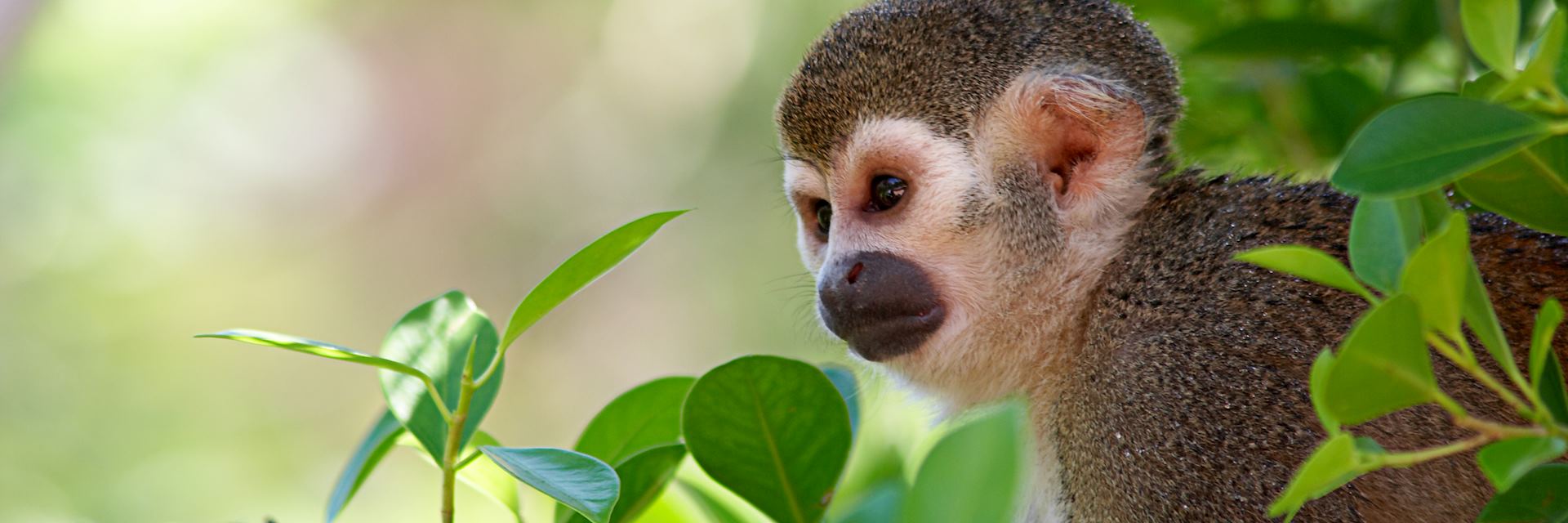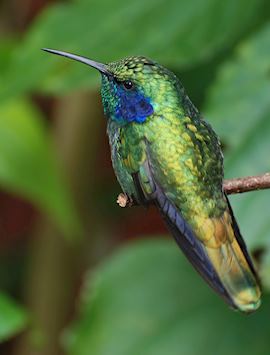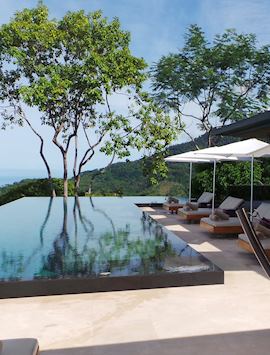By Audley specialist Holly
Picture this: it’s barely light. You’re still in your bathrobe when you step out onto your terrace at Lapa Rios in Costa Rica’s Osa Peninsula. There, in the branches of an overhanging tree, a pair of scarlet macaws are squabbling and munching on seeds. A coati and an agouti (ever-hungry native rodents) feast on the cast-off husks. Meanwhile, a black-mandibled toucan greets the dawn from another tree with its seagull-like caw.
It’s entirely possible to wake up to this menagerie on a trip to Costa Rica. And, while the country’s fauna and avifauna is worthy of lifelong study, you can delve into its richness on a two- or three-week wildlife-themed tour — if you know where to go.
Birdlife in Costa Rica
You could devote a whole trip just to Costa Rica’s birdlife. A multitude of intriguing species exist, and there are a few areas that make for especially fulfilling birdwatching.

Scarlet macaws, toucans and tinamous
To give yourself the very best chance of seeing scarlet macaws, head to the Osa Peninsula. More specifically, Corcovado National Park, where tropical rainforest rubs up against 23 miles (37 km) of surf-scourged coast. Here, you’re likely to find them sitting in pairs in wild almond trees, generally making a racket. They’re so prolific (and noisy) here that I’ve even heard them referred to as ‘Osa pigeons’.
Many types of toucan, toucanet and aracari also frequent the Osa’s rainforest. You’re more likely to see them from platforms and walkways high in the canopy where they live. A number of birds of prey haunt the Osa, too, including all kinds of falcons and the American kestrel.
And, out of all the birdsong you’ll hear in the Osa, the great tinamou has a particularly idiosyncratic call. A ground-dwelling, chicken-sized bird that’s mottled grey and brown, its song sounds like someone blowing wheezily on a flute.
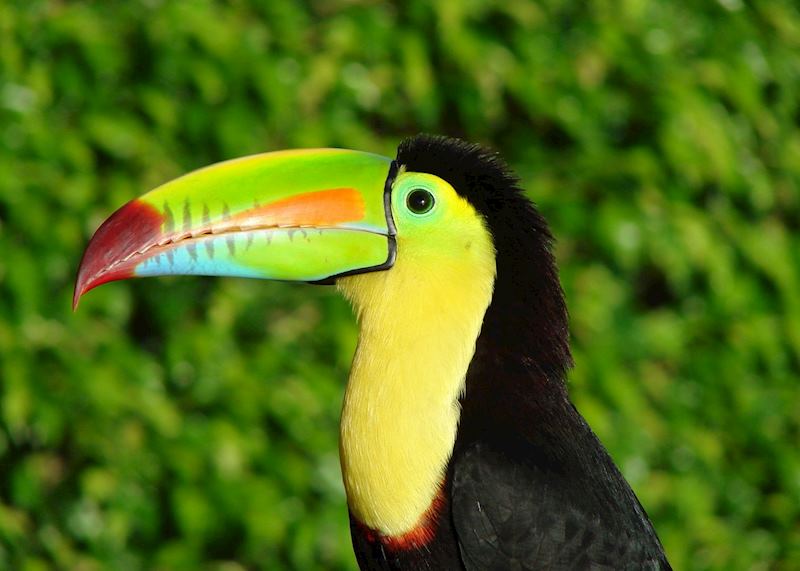
Quetzals and hummingbirds
The resplendent quetzal, with its exuberant spray of long tail feathers reminiscent of a Brazilian Carnival costume, is a bird of the cloudforest. To spot the quetzal, I lean toward the oak-and-fruit-tree-filled cloudforest of the quiet San Gerardo de Dota.
In this mountain village, you have no need to go into a reserve to find the quetzal. You can often see them feeding on wild avocado or blackberry trees from the village’s gravel roads.
Hummingbirds are one of the other great joys of Costa Rica’s birdlife, and there are hundreds of species. The good news is you can see them virtually all over the country, no matter where you’re staying, as most lodges have their own feeders. The most sought-after hummingbirds are the green-crowned brilliant, rufous-tailed, and violet sabrewing.
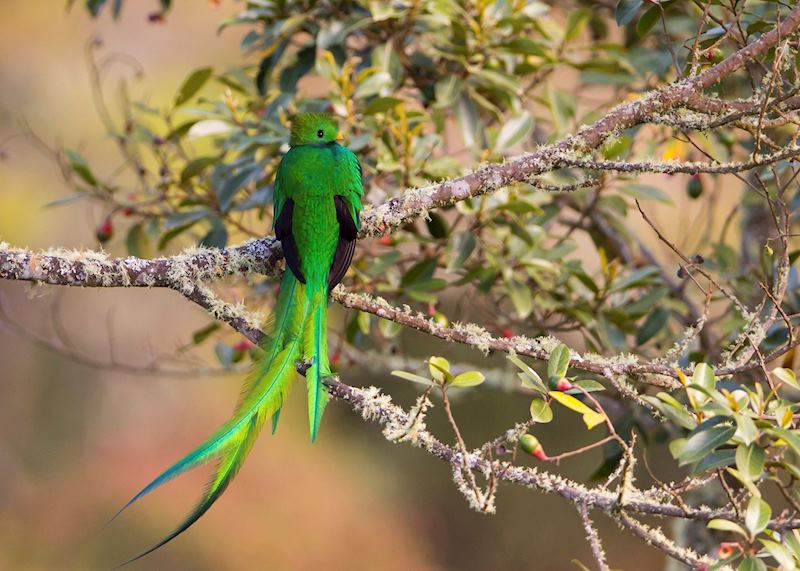

Selva Biological Station and Rancho Naturalista
Whatever your birdwatching interests, I recommend visiting the Selva Biological Station near Sarapiquí. There was so much to see, I barely had to leave the parking area. 900 species live here, including endemic birds such as the red-capped manakin, the slaty-tailed trogon, and the bare-necked umbrellabird, with its punky black quiff.
My go-to birdwatching-focused lodge is Rancho Naturalista, set amid the dairy farms and cheesemakers of the Turrialba region. It has a real home-from-home feel, and the guides are something else (they’re able to identify a species merely by the sound of its wings).

Reptiles to see in Costa Rica
Turtles
The opportunity to watch both nesting and hatching turtles is one of the great advantages of visiting Costa Rica in its green season. Tortuguero National Park, a marshy waterworld in the northeast of the country, is one of the best places for witnessing the phenomenon.
Between June and September, its beaches play host to high-octane dramas, as hundreds of kumquat-sized hatchlings make their perilous exodus from their discarded shells to the water. You might also see gravid females burying themselves in sand as they prepare to nest.
You usually go out in turtle-watching groups at dusk, using red filters on your torches so as not to disturb the youngsters or the mothers.
There are turtle-hatching sites all over Costa Rica’s coasts, but sightings are unpredictable. Another good spot, though, is Lagarta Lodge on the Nicoya Peninsula. It has a nearby beach, Ostional, where hatching and nesting goes on virtually year-round, and the team at the lodge will tell you where exactly to go.
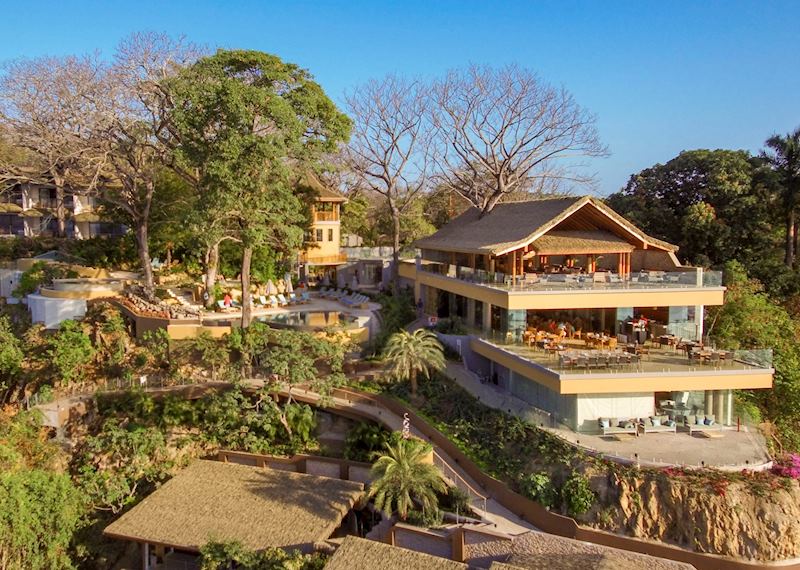
Basilisk lizards (Jesus Christ lizards)
The Tortuguero’s waterways are swimming with caiman, but I’d say the real star sight is the basilisk lizard. Look out for it on boat trips, where you might see it perched on the water’s edge. Then, at an unexpected sound or movement, you’ll see it scamper across the water (hence its nickname), using its long, spindly tail for balance.
Nocturnal wildlife in Costa Rica
Guided night-time rainforest or cloudforest walks are, for me, an essential of any Costa Rica wildlife tour. As the continuous rattle of cicadas fades out along with the daylight, you become privy to a whole new ecosystem.
Although you might come across nocturnal mammals — such as bush babies with their huge orb-like topaz eyes — night walks are really all about seeing the little things. You might observe stick insects, or identify a tarantula hole. Slender anole lizards can be seen sitting on leaf tops, and golden orb weaver spiders stay poised in the middle of their shimmering, silky webs. Cat-eyed snakes, no wider than a pencil, entwine themselves around branches.
Night walks are also about seeing the forests’ residents from a different perspective. I’ve really enjoyed spotting a toucan roosting with its head tucked under its wing, or some birds lined up on a branch, snoozing away.
The Osa Peninsula is the best place to see everything I mention here. There are also rewarding night walks in Monteverde or Sarapiquí (as mentioned on our blog).
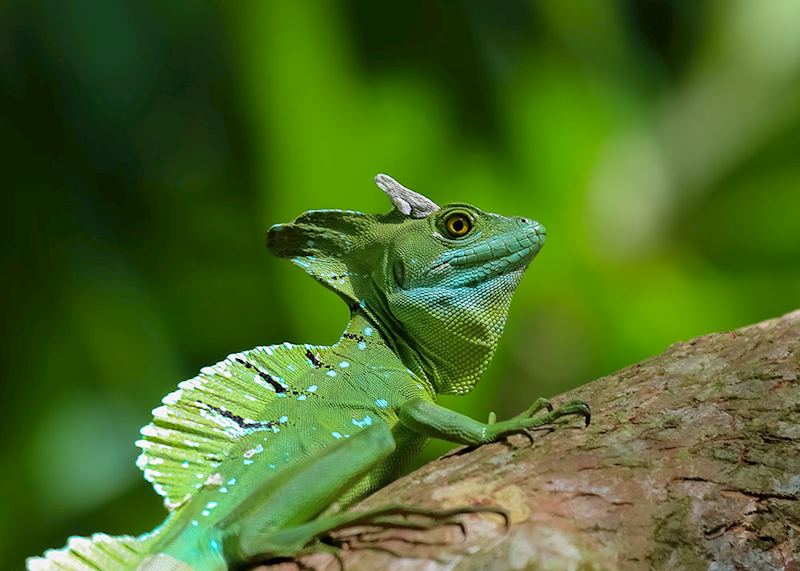
Tree frogs
As the light wanes, tree frogs begin their amorous nightly chants. Your guide might peel back leaves to reveal species such as red-eyed tree frogs, with their stripy bright blue and yellow sides and orange toes. Then you have glass frogs, with their translucent skin (you can even see their internal organs), and the more macho-looking gladiator tree frog. And, you might find smoky jungle frogs guarding their hollows on the forest floor.
You can also sometimes see tree frogs during the day, as well as on night walks. You’ll find red-eyed specimens in a pond near the Arenal Eco Termales hot springs complex, while one of my preferred lodges in Tortuguero, Mawamba, has a specially created frog garden with a tunnel — ideal for photographing these tiny amphibians.
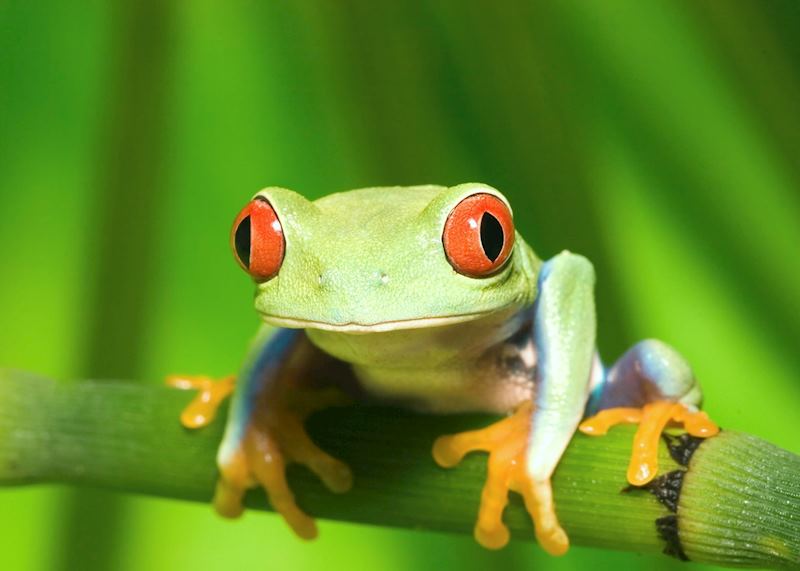
Mammals in Costa Rica
Sloths
The two- and three-toed varieties of sloth in Costa Rica often receive top billing among its cast of wildlife. Yet, they can be difficult to spot because their brownish-greyish-greenish coats make for good camouflage (the greenness comes from algae coating their hair).
Happily, though, they’re also prolific, and inhabit the country’s cloudforest, rainforest and dry forest. You’ll need to go high to see them. From canopy walkways, you might see shaggy blobs curled up in bundles in trees. Go with a guide, and take binoculars. Only then will you be able to see clearly their grinning faces, an expression set by the shape of their mouth.
They’re often easier to see when they come down to the ground (only once a week, to defecate). It’s actually more common to see them clinging to telegraph poles.
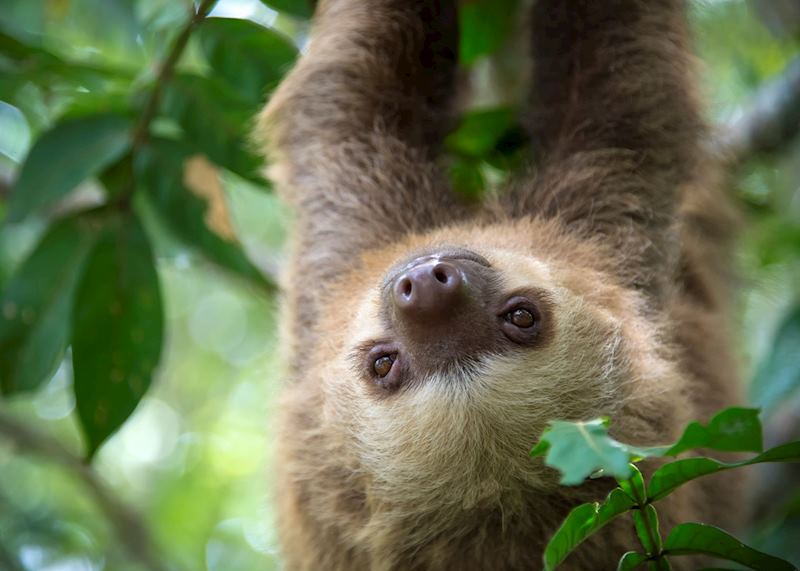
Monkeys
You’ll find four species of monkey in Costa Rica. They’re most visible in the Osa Peninsula, but you can also see some species in Tortuguero National Park and the Pacific coast’s Manuel Antonio National Park.
In Manuel Antonio, you’ll often find yourself facing down yellowy squirrel monkeys, who can be brazen and utterly unfazed by humans.
White-headed capuchins are the most outspoken of the lot. You might see them on rainforest trails, but also on lodge walkways in the Osa Peninsula and Tortuguero National Park (I had a staring match with one once, when it was standing in my path: it won.)
Mantled howler monkeys, glossy black with chestnut backs, hang around in large packs at the tops of tall ficus trees. Their growling, bellowing calls will act as your alarm clock — or warn you of a possible incoming rain shower.
Gangly limbed spider monkeys usually announce their arrival through a sudden crashing in the canopy, or by short bursts of high-pitched chatter. If you spot one, stay and watch the ensuing performance. They might look like gawky adolescents, but they’re elegant acrobats and use their prehensile tail as a fifth limb.
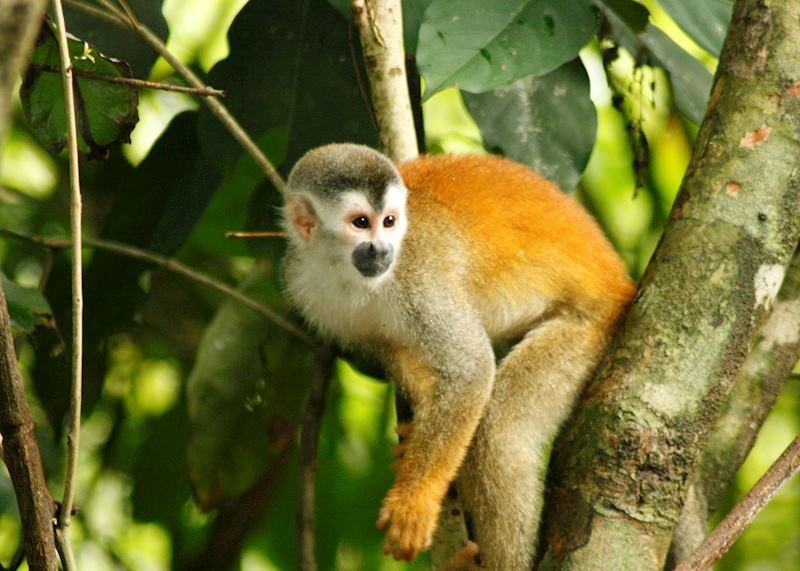
Rarer mammals in Costa Rica
You’ll see raccoon-like coatis and agoutis, which resemble oversized guinea pigs, almost everywhere in Costa Rica, to the point you become quite blasé about them. These aside, heavy-footed mammals are notoriously elusive. For the highest chances of seeing them, the Osa Peninsula is again your best bet.
You might be lucky and catch a rustling nine-banded armadillo going about its daily foraging on the edges of trails. Then there are tairas, which look like land-dwelling otters (you’ll also find these, incidentally, at Rancho Naturalista — see above). Ocelots are much harder to spot, as are jaguars, but one lodge in Osa, the Bosque del Cabo, has reported good sightings of pumas taking baths on their lawn.
Finally, there are Baird’s tapirs. Hook-nosed and grey-brown, they’re the size of a tubby miniature pony or large pig. Again, they’re hard to pin down, though you’ll see their tracks imprinted in muddy forest trails and on beaches.
Read more about trips to Costa Rica
Start thinking about your experience. These itineraries are simply suggestions for how you could enjoy some of the same experiences as our specialists. They’re just for inspiration, because your trip will be created around your particular tastes.
View All Tours in Costa Rica
